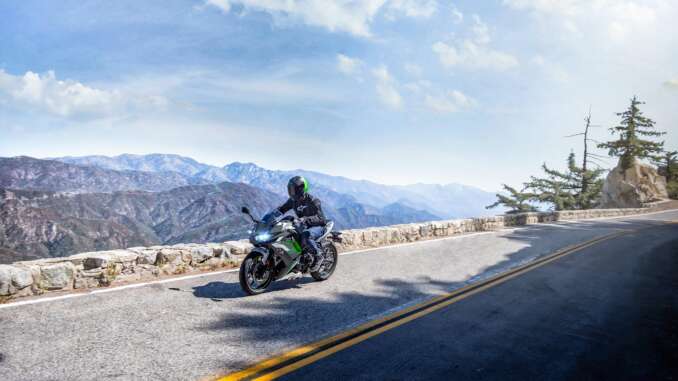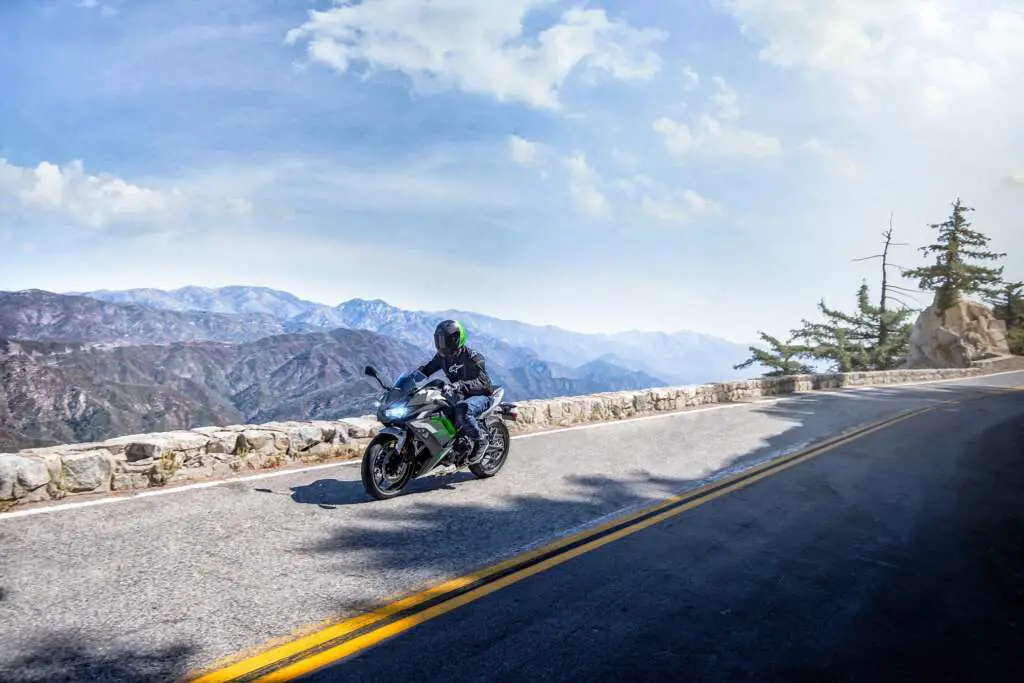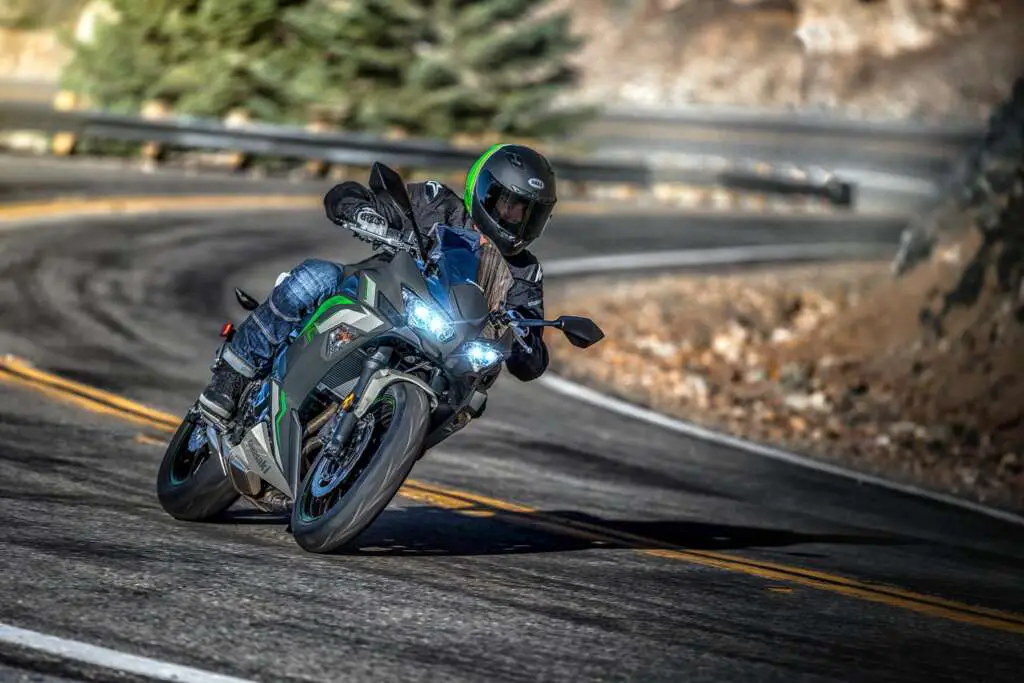
2022 Kawasaki Ninja 650: SUPREME LEVEL OF ATTITUDE.
Introducing the 2022 Kawasaki Ninja 650…
Reinvigorated to further embody Ninja sportbike lineage, the 2022 Ninja 650 sport motorcycle comes packed with a sporty 649cc engine, next-level technology advancements and sharp styling updates. Unmistakable sports performance is met with an upright riding position for exciting daily commutes, while a supreme level of attitude reminds you of its legendary heritage. The Ninja 650 also features sharper Ninja styling, Bluetooth Smartphone Connectivity via RIDEOLOGY THE APP, twin LED headlights, upper cowl and windshield, passenger seat, and Dunlop Sportmax Roadsport 2 tires.
2022 Kawasaki Ninja 650 Totalmotorcycle.com Key Features
- DIGITALLY FUEL-INJECTED 649cc PARALLEL-TWIN ENGINE
- TWIN LED HEADLIGHTS
KAWASAKI BEGINS EARLY PRODUCTION OF 2022 STREET MOTORCYCLES
Over the course of 2021, the powersports industry saw a significant increase in popularity with new and experienced riders alike, turning to motorcycles, ATVs, side-x-sides, and personal watercrafts. To meet this growing demand Kawasaki is moving up the production and introduction of select model year 2022 motorcycles. Kawasaki has selected a range of supersport, sport, naked and cruiser models that will arrive in Kawasaki dealerships during the summer months so that more riders have a chance to “Let the good times roll®.”
2022 Kawasaki Ninja 650 Totalmotorcycle.com Features and Benefits
Assist & Slipper Clutch
Based on feedback from racing activities, the Assist & Slipper Clutch uses two types of cams (an assist cam and a slipper cam) to either drive the clutch hub and operating plate together or apart.
Under normal operation, the assist cam functions as a self-servo mechanism, pulling the clutch hub and operating plate together to compress the clutch plates. This allows the total clutch spring load to be reduced, resulting in a lighter clutch lever feel when operating the clutch.
When excessive engine braking occurs – as a result of quick downshifts (or an accidental downshift) – the slipper cam comes into play, forcing the clutch hub and operating plate apart. This relieves pressure on the clutch plates to reduce back-torque and helps prevent the rear tire from hopping and skidding. This race-style function is particularly useful when sport or track riding.
Dual Throttle Valves
Late-model sport bikes often use large-bore throttle bodies to generate high levels of power. However, with large diameter throttles, when a rider suddenly opens the throttle, the unrestricted torque response can be strong. Dual throttle valve technology was designed to tame engine response while contributing to performance.
On models with dual throttle valves, there are two throttle valves per cylinder: in addition to the main valves, which are physically linked to the throttle grip and controlled by the rider, a second set of valves, opened and closed by the ECU, precisely regulates intake airflow to ensure a natural, linear response. With the air passing through the throttle bodies becoming smoother, combustion efficiency is improved and power is increased.
Economical Riding Indicator
Using high-precision electronic control for engine management, Kawasaki models can achieve a high level of fuel efficiency. However, fuel consumption is greatly affected by throttle use, gear selection, and other elements under the rider’s control. The Economical Riding Indicator is a function that indicates when current riding conditions are consuming a low amount of fuel. The system continuously monitors fuel consumption, regardless of vehicle speed, engine speed, throttle position and other riding conditions. When fuel consumption is low for a given speed (i.e. fuel efficiency is high), an “ECO” mark appears on the instrument panel’s LCD screen. By riding so that the “ECO” mark remains on, fuel consumption can be reduced.
While effective vehicle speed and engine speed may vary by model, paying attention to conditions that cause the “ECO” mark to appear can help riders improve their fuel efficiency – a handy way to increase cruising range. Further, keeping fuel consumption low also helps minimize negative impact on the environment.
Horizontal Back-link Rear Suspension
Compared to the Kawasaki traditional Uni-Trak® rear suspension, which mounts the shock unit vertically, with Horizontal Back-link Rear Suspension, the shock unit is almost horizontal. The original Kawasaki suspension arrangement locates the shock unit very close to the bike’s center of gravity, greatly contributing to mass centralization. And because there is no linkage or shock unit protruding beneath the swingarm, this frees up space for a larger exhaust pre-chamber (an exhaust expansion chamber situated just upstream of the silencer). With a larger pre-chamber, silencer volume can be reduced, and heavy exhaust components can be concentrated closer to the center of the bike, further contributing to mass centralization. The result is greatly improved handling.
A secondary benefit is that the shock unit is placed far away from exhaust heat. Because it is more difficult for heat from the exhaust system to adversely affect suspension oil and gas pressure, suspension performance is more consistent.
2022 Kawasaki Ninja 650 – Totalmotorcycle.com USA Specifications/Technical Details
US MSRP Price: $7699 – $7899 USD
Canada MSRP Price: $ CDN
Europe/UK MSRP Price: £ See Dealer GBP (On The Road inc 20% Vat)
POWER
Engine 4-stroke, Parallel Twin, DOHC, 8-valve, liquid cooled
Displacement 649cc
Bore x Stroke 83.0 x 60.0mm
Compression Ratio 10.8:1
Fuel System DFI® with dual 36mm Keihin throttle bodies
Ignition TCBI with electronic advance
Transmission 6-speed
Final Drive Sealed chain
PERFORMANCE
Front Suspension / Wheel Travel 41mm hydraulic telescopic fork/4.9 in
Rear Suspension / Wheel Travel Horizontal back-link with adjustable spring preload/5.1 in
Front Tire 120/70×17
Rear Tire 160/60×17
Front Brakes Dual 300mm petal-type discs and 2-piston calipers
Rear Brakes Single 220mm petal-type disc and single-piston caliper
DETAILS
Frame Type Trellis, high-tensile steel
Rake/Trail 24.0°/3.9 in
Overall Length 80.9 in
Overall Width 29.1 in
Overall Height 45.1 in
Ground Clearance 5.1 in
Seat Height 31.1 in
Curb Weight 423.4lb
Fuel Capacity 4.0 gal
Wheelbase 55.5 in
Color Choices Metallic Matte Graphenesteel Gray, Pearl Robotic White/Metallic Carbon Gray
Warranty 12 Month Limited Warranty
Kawasaki Protection Plus™ (optional) 12, 24, 36 or 48 months
2022 Kawasaki Ninja 650 – Totalmotorcycle.com Canadian Specifications/Technical Details
TBA
2022 Kawasaki Ninja 650 – Totalmotorcycle.com European Specifications/Technical Details
Engine
Engine type Liquid-cooled, 4-stroke Parallel Twin
Compression ratio 10.8:1
Valve system DOHC, 8 valves
Bore x stroke 83.0 x 60.0 mm
Displacement 649 cm³
Displacement 649 cm³
Fuel system Fuel injection: Ø 36 mm x 2 with dual throttle valves
Starting System Electric
Lubrication Forced lubrication, semi‑dry sump
Gear Performance & Transmission
Maximum torque 64 N•m {6.5 kgf•m} / 6,700 rpm
Maximum power 50.2 kW {68 PS} / 8,000 rpm
CO2 emission 107 g/km
Fuel consumption 35 kW kit 4.5 l/100 km
CO2 emission 35 kW kit 107 g/km
Transmission 6-speed, return
Clutch Wet multi-disc, manual
Primary Reduction Ratio 2.095 (88/42)
Gear Ratios 1st 2.438 (39/16)
Gear Ratios 2nd 1.714 (36/21)
Gear Ratios 3rd 1.333 (32/24)
Gear Ratios 4th 1.111 (30/27)
Gear Ratios 5th 0.966 (28/29)
Gear Ratios 6th 0.852 (23/27)
Final drive Sealed chain
Final reduction ratio 3.067 (46/15)
Suspensions Brakes & Suspension
Brakes, front Dual semi-floating 300 mm petal discs. Caliper: Dual piston
Brakes, rear Single 220 mm petal disc. Caliper: Single-piston
Suspension, front 41 mm telescopic fork
Suspension, rear Horizontal Back-link with adjustable preload
Dimensions Frame & Dimensions
Frame type Trellis, high-tensile steel
Trail 100 mm
Wheel travel front 125 mm
Wheel travel rear 130 mm
Tyre, front 120/70ZR17M/C (58W)
Tyre, rear 160/60ZR17M/C (69W)
Tyre, rear 160/60ZR17M/C (69W)
L x W x H 2,055 x 740 x 1,145 mm
Wheelbase 1,410 mm
Ground clearance 130 mm
Fuel capacity 15 litres
Seat height 790 mm
Curb mass 193 kg
Manufacturer Specifications and appearance are subject to change without prior notice on Total Motorcycle (TMW).




